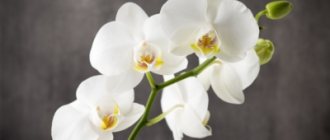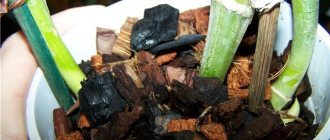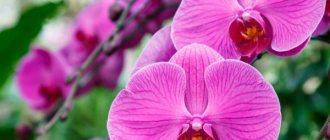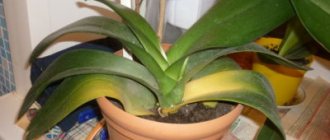The main value of most types of orchids lies in their lush and long-lasting flowering. For the sake of the appearance of magnificent flowers on exotic beauties, flower growers are ready to create tropics in city apartments and fulfill all the whims of the “daughters of the air.”
The biggest trouble for orchid lovers is if all the flowers or buds that are ready to bloom have fallen off, which can happen due to the slightest violation of the care regimen.
To prevent this problem, before purchasing tropical plants, it is advisable to thoroughly study and then carefully follow the recommendations for growing them at home.
Duration of orchid flowering
Each orchid specimen has its own unique flowering schedule: the beginning of bud formation often shifts by month , flowering can occur at any time of the year and more than once per season.
Orchids do not have clear flowering periods.
IMPORTANT! The timing and duration of flowering of an orchid depend on its type and the conditions created for the plant in indoor culture.
Even with proper care, the duration of preservation of the decorative appearance of flowers varies significantly, but on average it is approximately 3 months (a separate corolla can bloom for up to a month). Young orchids most often fade within a month; the flowering of some adult plants takes up to six months or more (if the flower has produced several peduncles, which subsequently bloomed in the second round).
Day-lily
The water requirement of this crop increases during the budding period. Do not allow the soil around the plant to dry out. Sharp fluctuations in humidity are also harmful to daylilies. The flower stalks may wither and flowering will not be abundant.
Plants are watered by sprinkling. In spring, watering is especially important. Daylilies do not like surface irrigation of the soil. It is better to water less often, but more abundantly. The soil should be soaked 30 cm deep. Optimal water temperature is +25°C.
The difference between natural wilting and dropping flowers
The fall of an orchid's flowers is not always caused by negative reasons. If gradual and smooth fading occurs, which begins from the lower tiers of the peduncle (from the corollas that bloomed first), then this means the natural process of aging of the flowers.
In this case, there is no reason to worry - the plant should be provided with normal care and wait for the next flowering period.
But if the flowers and buds dry and fall off instantly and at the same time, and the plant loses its decorative effect, then this is a sure sign of a violation of the favorable conditions for keeping the tropical beauty.
It is necessary to immediately determine the cause of the trouble and try to minimize the negative consequences.
Why do the buds wither?
An orchid's buds may wilt if the plant itself is stressed or exposed to adverse environmental factors.
Most often, the reason for the wilting of buds is
a sudden change in the conditions in which the flower was previously kept.
If the buds of a newly acquired flower have withered, then this is not surprising. Because in a short time the plant has changed at least several habitats.
In the greenhouse, all the necessary conditions were created for the orchid, but this cannot be repeated in your own apartment.
Lack of lighting, temperature changes and dry air provoke wilting of the buds. Hypothermia of the substrate and the plant itself also leads to the withering of the buds, after which they fall off. For an orchid, the critical ambient temperature is + 15C .
If the plant is also watered abundantly, then the loss of buds is guaranteed. In the cold season, the gardener must be prepared for such an outcome.
One type of hypothermia is a draft .
As soon as the orchid stands in a strong draft for even a few minutes, literally by the evening of the same day all the buds will be sluggish.
In addition, a draft can negatively affect not only the buds, but also the plant as a whole.
never ventilate a room if the orchid has just been watered or sprayed .
Spraying the buds can also cause them to wilt. Experts recommend avoiding such manipulations.
Even if the buds do not wither, brown spots from drops will be very noticeable on the opened flowers.
You can only spray green mass, and only if you are sure that the air is really dry and the ambient temperature corresponds to the required one.
What to do if the orchid's flowers have fallen?
The orchid perceives any change in comfortable maintenance parameters as a stressful state and can react by drying out and dropping flowers - the plant enters the survival phase and eliminates all factors that interfere with this process. And since flowering takes too much effort, the buds and flowers of the orchid only get in the way.
It is not possible to stop the process of flower loss in a number of situations. The aging of a plant (over 7 years old), which does not have enough strength to open the formed buds, or the drying of flowers after pollination by random insects is natural and does not cause harm to the plant. The orchid needs standard care until a new shoot forms.
Old orchids often do not have enough strength to open their buds.
The shedding of buds is also irreversible due to the following reasons:
- death of roots from overwatering;
- frostbite of the above-ground part;
- sudden change in conditions of detention.
All flower stalks should be removed to facilitate the orchid's recovery process and care regimens adjusted.
All other factors of improper care that caused the tropical beauty to refuse to bloom can be quickly corrected to stop the buds from falling off and restore interrupted flowering.
A positive effect is achieved by eliminating violations of the watering and fertilizing regime, correcting temperature indicators, air humidity or illumination . It is also necessary to remove bouquets of flowers and fruits from the orchid - the ethylene they produce does not contribute to the opening of the buds.
By quickly diagnosing the reasons for the falling off of orchid buds and flowers and promptly changing the wrong aspects of maintenance, it is possible in some cases to ensure that the tropical beauty continues to bloom.
Such a favorable outcome can be hoped for with very minor and short-term violations of the conditions of detention, as well as with timely elimination of exposure to ethylene from fruits or cut flowers.
If negative changes in the conditions of detention were not detected in time and acted for a long time, this leads to the complete fall of the buds and flowers that have begun to bloom.
A plant damaged in this way requires an assessment of its condition and enhanced care and restoration measures.
Finding out the reason
To ensure proper care and restore regular flowering, it is necessary to find out the reason for the dropping of flowers and buds . This is achieved by visual inspection of the plant and analysis of all care regimens.
At the first stage, the possibility of pollination and the age characteristics of the “daughters of the air” are assessed. If the symptoms fit one of these points, then the orchids are left alone and wait for the next peduncle.
Otherwise, consider possible care errors that cause a stressful state in the plant:
- Lighting primarily affects the release of buds. For normal flowering, the exotic beauty needs bright and diffused light for at least half of the day. This is especially true during the cold season;
For full development, the orchid requires a lot of diffused sunlight.
- Temperature fluctuations in any direction can cause the fall of both blossoming flowers and closed buds. In summer, the cause may be overheating or burns of a plant exposed to direct sunlight for a long time. In winter, there are many more such factors: sudden changes in temperature due to a nearby central heating battery;
- cooling the roots and the plant itself, standing next to a window glass or on a cold windowsill (readings below +15°C are not advisable);
- influence of drafts.
Vegetables and fruits that emit ethylene.
- moving “daughters of the air” from place to place is not the best option for capricious beauties. This may cause flowering failure.
After identifying the cause that led to the loss of flowers, you should immediately begin to adjust the growing conditions.
Growing conditions
It is not always possible to return to standard care indicators after shedding flowers to restore a damaged peduncle, but careful implementation of all regimes will contribute to the rapid formation of new flower shoots.
Optimal lighting
It is created by placing the plant on the east or south side of the house with obligatory shading during the summer afternoon hours, which will save the orchid from burns. In the cold season, illumination with daylight spectrum lamps is required, especially in the evenings.
Exotic beauties are light-loving flowers; they respond positively to the creation of bright, long-lasting and diffused lighting.
Temperature
For comfortable growing of orchids, it should ideally correspond to 23 – 27 °C . To prevent sudden temperature changes, the plant is placed away from radiators and window glass ; in winter, it is good to provide a warm buffer on the windowsill. And be sure to protect your tropical guest from cold drafts.
Air humidity
Should be increased to optimal readings (55 – 70%) using humidifiers or water vessels. Regular “foggy” spraying of leaves in the morning will have a beneficial effect. It is possible to use the double bottom principle in a pot.
Proper watering
It is regulated by visual observation of the orchid: if there is no condensation on the inner surface of the pot, and the protruding roots have slightly changed color to a grayish tint, then it is time to carry out the next watering ( approximately once a week , but with mandatory adjustments due to temperature changes).
Determining the need for watering.
ATTENTION! Water for watering orchids should be warm and settled. Never water the “daughters of the air” with cold water!
Assessing the condition of the peduncle
If, after the massive fall of flowers as a result of care errors, the peduncle does not dry out, retains its erect position and green color, and the dormant buds at its base look alive and healthy, then there are prerequisites for repeated flowering on the same arrow . It is only necessary to adjust the plant’s maintenance regime.
A situation is possible when the top of the peduncle has dried up to half, and then a green stem with swelling dormant buds - meristems - has remained.
In this case, the dried part should be removed , leaving a small dry area (if you cut it down to a living stem, the stopped drying process may resume).
After the normalization of care schedules, the kidneys may give rise to a new arrow or children.
Checking the feasibility of saving the green arrow
In the case when the flowers have fallen, what to do next with the arrow depends on whether it has dried out or remains green. preserved after the flowers have been shed can still be of benefit to the orchid , since there are several dormant buds at its base. Under certain conditions, meristems are capable of forming new flower stalks, which gives reason to hope for repeated flowering.
In addition, meristems can participate in vegetative propagation of an orchid , forming one or more children. Therefore, it is not recommended to remove the green peduncle immediately after all the flowers have fallen off - you should wait for the possible awakening of the buds.
Find out the timing of the final removal of the peduncle
Some flower stalks, after the end of flowering or the unwanted shedding of flowers and buds, are capable of forming new arrows on their stems for more than one year. Therefore, the timing of the final removal of such peduncles may be postponed for several years.
Sometimes a new arrow may begin to grow on a dried peduncle.
ADVICE! It is advisable to cut off any peduncle of a healthy orchid only after it has completely dried naturally.
The healthy green arrow can be removed if necessary: if the plant is severely weakened and requires time to rest and recover.
Main reasons
When the active flowering phase begins and the orchid suddenly drops its flowers, the gardener wonders what he is doing wrong? There may be many reasons , but it all comes down to one thing: the plant is not properly cared for and does not have enough strength to fully flower. You need to analyze your mistakes and correct them.
Main reasons:
- The natural aging process of a flower;
- Change of place of growth;
- Poor quality substrate;
- Improperly organized watering process.
If the plant is constantly deprived of light and heat, grows in poor-quality bark and stands in a draft , then this bush cannot be expected to send out a flower shoot.
Therefore, it is necessary to create suitable conditions for growth . Do not forget about the necessary fertilizing for the orchid, and then it will delight the grower with its flowering.
The age of the plant does not affect the quality of flowering , you just need to properly care for the orchid and not overfeed it with nitrogen.
If the plant is not cultivated correctly, even on an already expelled flower shoot with buds, force majeure may occur and the buds will fall off. Therefore, you need to know in what situations this can happen in order to avoid such a situation.
Indoor humidity
In its homeland, the orchid begins to bloom during the rainy season. This means that it needs high humidity during this period. Each genus and type of orchid requires its own level of humidity, and it is difficult to give any general recommendations. You need to know the exact name of the genus and species of your orchid and look for information on humidity specifically for it.
BUT! If you have an ordinary hybrid phalaenopsis from a supermarket, then they do not need to create high humidity; 40% will be enough for normal flowering.
But some natural types of orchids require a humidity of at least 70%, and some even 90% . Otherwise, the orchid may lose its bloom and go into a dormant stage.
Therefore, if you find out that your type of orchid needs high humidity, then in the hot season or during the heating season you need to place containers of water near the flowers, increasing the humidity. Or use humidifiers.
Some natural orchid species require a humidity of at least 70%. For most hybrid phalaenopsis, 40% will be enough.
Illumination
This reason for the plant to shed its buds appears in autumn and winter. Since at this time the sky is often cloudy and the plant does not have enough sunlight.
If an orchid drops flowers, what should you do? First of all, in order not to lose flowering, during this period it is necessary to illuminate with specialized lamps. Lamps (or LED strips) can be purchased at flower shops or on Aliexpress.
Also, many people do not bother with expensive phytolamps and use ordinary fluorescent fluorescent lamps for 100-150 rubles to illuminate shelves with their plants.
When illuminated with lamps, they are placed at such a distance so as not to burn the flower with heat.
In autumn and winter, orchids are illuminated with phytolamps.
Content temperature
The orchid loves an even temperature, ranging from 22-26 degrees Celsius . Deviations in any direction in the temperature regime are regarded as critical, and this leads to the fact that the flowers wither and crumble. Therefore, it is important to place the flower in hot weather so that the air is not hot, and in winter - too cold.
Sunburn
Direct sunlight causes burns not only of buds and flowers, but also of the leaf mass. A plant placed in direct sunlight in summer can burn in 10 minutes . Therefore, when placing a plant, this must be taken into account so as not to regret later about the ruined flower.
Drafts
Although the plant loves fresh air, it must be borne in mind that a cold draft may well destroy the plant . Therefore, it is necessary, especially in winter, to ensure that the flower does not receive cold winter air. After all, our temperature in winter drops to a strong minus, and this will be detrimental to the orchid as a whole, and not just to the buds and flowers.
Irrigation regime violations
When watering flowers during their flowering period, you should not flood them, but let the substrate dry out between waterings . Otherwise, problems with the root system will begin, and the flower will quickly throw off its flowers to protect its life. If the orchid experiences constant drought, then in this case the buds will be dropped without blooming.
Water the orchids after the substrate has completely dried.
Finding the plant next to wilting crops
If your orchid has dropped flowers, check for ethylene sources nearby. Experienced flower growers believe that you should not place a blooming orchid next to fruits and vegetables , as this can cause the flowers to wither. Whether this is true has not been proven by science, but you can, just in case, not put them together.
Possibility of re-blooming
If minor mistakes were made in the maintenance of the orchid and it dropped its flowers, what to do next? In this case, the plant will need some time to recuperate and normalize life processes . Only after this and subject to elimination of defects in care is it possible for the tropical beauty to bloom again.
For the reappearance of buds after the flowers have completely fallen off, it will take a certain time and certain conditions must be met:
- eliminating all mistakes made in orchid care regimens;
- restoring the strength of the plant by carefully following the rules of care;
- growth of green mass by the plant - in monopodial species, the formation of a new peduncle is possible after the growth of the next leaf;
- preservation of the old peduncle from which the flower has fallen, and the presence of viable meristems on it;
- normalization by the plant of flowering periods inherent in each species, subject to their violation.
It is common practice for most orchid species to rebloom after approximately 3 months . Having finished the first flowering or dropping its buds for some reason, the plant begins to build up above-ground mass, which helps it gain strength. After this, a new flower arrow appears or a meristem awakens on a peduncle that has lost flowers.
But if the first flowering occurred at a time that was uncharacteristic for a particular species, then the next formation of flower stalks will occur no earlier than the plant adjusts the timing of its flowering.
Step-by-step instructions on what to do to save the plant
Saving an orchid is not as difficult as it might initially seem. The main thing is to know what actions to perform and in what sequence.
With blossoming flowers
- Isolate the culture from other indoor plants.
- Inspect, if pests are present, remove.
- Maintain +24 degrees during the day, +18 degrees at night.
- Raise humidity if it is low.
- Keep the substrate moist.
- Prevent drafts.
With unopened buds
- Isolate the crop from other plant varieties.
- Inspect for pests and carry out treatment.
- If the plant has been moved, return it to its original place.
- If there is a shortage of light, use another lamp.
- Stick to a watering schedule.
- Add fertilizer.
- Maintain suitable temperature conditions.
- If the humidity is high, reduce it.
Rules for watering and fertilizing
When flowers fall off due to flooding of the plant, this means that the root system is damaged . The orchid should be replanted, while treating the roots (remove damaged areas and disinfect). After this, do not water for about 10 days, and then carefully follow the watering schedule - once a week, allowing the substrate to dry.
The flooded orchid should first be replanted.
If replanting is not carried out, then the flooded plant, which has lost its color, should first be dried and then gradually introduced to the correct watering regime.
When shedding flowers from drying out soil, the orchid is first soldered by immersing the pot in a vessel with water , and then the watering schedule is normalized.
The same rules apply to fertilizing. If an orchid has dropped its flowers due to overfeeding, then you should try to wash out excess fertilizer from the soil or replace the substrate.
CAREFULLY! After replanting a plant that has stopped flowering due to excessive fertilization, fertilizing should not be applied for 3 to 6 months.
The lack of nutrition that led to the fall of the buds should be replenished gradually. It is necessary to adjust the feeding schedule and apply it once a month with watering, using half the dose indicated on the package.
Preventive actions
Most diseases of rose bushes are quite difficult to treat, so it is most advisable to competently and timely carry out all preventive measures aimed at reducing the damage to rose bushes by diseases and damage by plant parasites:
- The formation of rot on buds can be prevented by limiting irrigation activities in rainy weather and fertilizing with manganese-containing fertilizers with preliminary removal of damaged peduncles;
- good results are obtained by foliar feeding of garden roses with an infusion based on nettles and garlic as a preventive measure against damage to ornamental crops by aphids and thrips;
- in the autumn, it is necessary to collect fallen leaves, followed by digging up the soil and spraying the rose bushes with Intavir or Iskra;
- if necessary, during the growing season, every ten days it is allowed to spray rose bushes with a copper-soap solution prepared at the rate of 0.3 kg of crushed laundry soap and 30 g of copper sulfate per bucket of warm water.
Also, in addition to the prevention of diseases and pests, it is very important to ensure that the ornamental crop is properly placed on the site and properly cared for at all stages of the growing season, including such activities as watering, fertilizing, timely pruning and shaping the bush, as well as weeding and loosening the soil in tree trunk circles .
In contact with
Need for transplant
If a plant loses its color as a result of problems with the root system, then the question arises about the need to replant the specimen. Orchid roots can be damaged by various factors.
Improper watering leads to rotting (with frequent watering) or drying out (with insufficient moisture) of the underground part. The roots gradually die off; they do not have enough strength to provide the green mass with water and nutrition.
The plant is forced to give up flowers in order to survive. In this case, transplantation and root treatment are vital.
Sometimes, if the substrate is not selected correctly, a whitish dry coating forms on the protruding parts of the root and the edges of the flowerpot. This is a sign of alkalization , which can lead to flower drop. To improve growing conditions, the plant is recommended to be replanted.
Phloxes
It is recommended to pour 2 buckets of water per 1 m² of soil. In hot weather, phloxes are watered even more often. The water must completely wet the soil. After watering, the soil is loosened.
To irrigate this crop, experienced gardeners use sprinkling. It takes place in the afternoon. Check that the water does not contain salts harmful to the plant.
If the second part of the season is too warm, phloxes stop growing and do not accumulate nutrients. In this case, you need to water even after flowering.
Resetting flowers after purchasing in a store
Moving a plant from a store to an apartment after purchasing it can be called a highly stressful state. Therefore, it is not at all surprising that the orchid reacts to this by losing flowers and buds.
Causes of the phenomenon
Color reset after purchase in a store may be due to several reasons:
- the plant was exposed to stress due to the move;
- when purchased in winter and not properly packaged, frostbite occurs on the delicate buds;
- The orchid in the store bloomed for quite a long time, and the dropping of flowers in the apartment is simply the natural aging of the corollas.
An orchid may drop its flowers after purchase for various reasons.
ADVICE! In order for an orchid to delight you with its flowering for a long time after purchase, you need to choose specimens with the least number of open buds.
Risk reduction
To help an orchid survive the stress associated with the purchase, you should thoroughly think through the possible risks and try to anticipate all difficulties.
It is better to purchase the plant in summer and in calm weather.
When purchasing in winter, you need to stock up on special packaging material and transport the tropical beauty by car. Upon arrival home, you should immediately locate the plant in a permanent place and leave it without watering and with sufficient lighting for acclimatization.
Bells
Ampelous bells are watered abundantly. The green parts of the plant are sprayed daily with a spray bottle. The soil around the stem should never dry out. In winter, this crop is placed in a room with a temperature of +12°C, and watering is significantly reduced.
Bluebells growing in open ground need to be watered only when there is prolonged heat. After irrigation, it is advisable to loosen the soil around so that a crust does not form on the surface.
- Author: Zimina Tatyana
Rate this article:
- 5
- 4
- 3
- 2
- 1
(0 votes, average: 0 out of 5)
Share with your friends!
Risk factors
Orchids are real sissies, so an unusual proximity can harm them. They do not tolerate close proximity to nuts, bananas, apples and tomatoes. The fact is that they contain a large amount of ethylene, which negatively affects the growth of the orchid. It is worth noting that fading flowers located nearby can also negatively affect the condition of the plant (you can find out why an orchid withers and how to save a flower here).
Neighborhood with a variety of fruits and flowers can provoke rapid aging of the plant, falling of leaves and buds. Flower growers carefully monitor what is close to the orchid, so they avoid possible proximity to destructive representatives of the flora.
Of course, such plants can get rid of buds on their own, but this will only happen when the flower has already faded. There is no need to worry, because this is a natural process. It happens all the time, so you need to monitor it and under no circumstances remove the buds. You can simply damage the plant in this way and lead to its death. It is worth noting that if the flowers have not yet bloomed, but have begun to fall off, this indicates the presence of pests or diseases.











